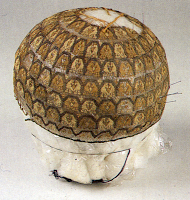There are things, persons, occurrences on markets like that last weekend that really warm the heart or make you see again why you sit and explain how something works for two days in a row, telling the same tales a hundred times.
One was the lady stopping by again on the second day. On Saturday, she'd seen my bone awl that I use for making eyelet holes and asked for an explanation, since she had one at home but didn't know what it was for. We also chatted about netting needles and tatting, since she described a tatting shuttle to me, asking what it could have been for.
On Sunday, she came to show me the tools we had talked about - and said that since she would not use the netting needles nor the tatting shuttle, she's giving them to me. So I came back from the market with three more textile tools - at least two of them very hard to get.
She made me very happy with these absolutely unexpected presents - and helped me to learn more about the size, form and shape of industrially produced modern (but not really contemporary) netting needles.
The other was the little girl whom the spinner brought over from the spinning booth with the words "And look here, the weaver - that's where the finished thread goes." So she got handed to the weaver for an explanation and demonstration of weaving on a four-shaft loom, and then she came over to me to look at clothes.
After showing her some seams and some garments, I took out a piece of fine silk cloth and explained that even cloth so fine as this was all worked by hand - and then I told her to imagine how long that must take, all those superfine threads, all made and then woven... and she stood in front of my tent for, oh, two minutes, looking totally stunned and saying no more than "Oh. Wow. Oh." while trying to get a grasp on this gigantonormous amount of time and work.
Little lady: Thank you. You really made my day by listening and thinking about what we demonstrated. Seeing you so awed makes me very, very happy.
One was the lady stopping by again on the second day. On Saturday, she'd seen my bone awl that I use for making eyelet holes and asked for an explanation, since she had one at home but didn't know what it was for. We also chatted about netting needles and tatting, since she described a tatting shuttle to me, asking what it could have been for.
On Sunday, she came to show me the tools we had talked about - and said that since she would not use the netting needles nor the tatting shuttle, she's giving them to me. So I came back from the market with three more textile tools - at least two of them very hard to get.
She made me very happy with these absolutely unexpected presents - and helped me to learn more about the size, form and shape of industrially produced modern (but not really contemporary) netting needles.
The other was the little girl whom the spinner brought over from the spinning booth with the words "And look here, the weaver - that's where the finished thread goes." So she got handed to the weaver for an explanation and demonstration of weaving on a four-shaft loom, and then she came over to me to look at clothes.
After showing her some seams and some garments, I took out a piece of fine silk cloth and explained that even cloth so fine as this was all worked by hand - and then I told her to imagine how long that must take, all those superfine threads, all made and then woven... and she stood in front of my tent for, oh, two minutes, looking totally stunned and saying no more than "Oh. Wow. Oh." while trying to get a grasp on this gigantonormous amount of time and work.
Little lady: Thank you. You really made my day by listening and thinking about what we demonstrated. Seeing you so awed makes me very, very happy.








